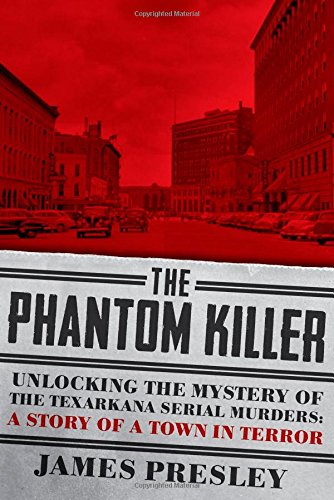by Don Stradley
That is, until the killer arrived.
 He was darkness personified, slipping in and out of murder scenes undetected,
preying on parked couples, leaving virtually no trail. Over the course of several weeks, he shot and
killed five people in cold blood, and inflicted physical harm on three
others. The town panicked. Evil was in
the air.
He was darkness personified, slipping in and out of murder scenes undetected,
preying on parked couples, leaving virtually no trail. Over the course of several weeks, he shot and
killed five people in cold blood, and inflicted physical harm on three
others. The town panicked. Evil was in
the air.
Presley’s highly detailed recounting of the murders, the
bumbling investigation, the media blitz, and the aftermath, shows us that evil isn’t
something that comes up from a netherworld. Rather, it can come in the guise of
a plain bumpkin, in this case, a local hick named Youell Swinney. A 30-year-old
ex-con, Swinney was the youngest son of a Baptist minister and was known for
having a violent streak. When Texarkana
cops busted him for car theft, he all but confessed to the murders. His wife provided damaging statements that convinced every
cop on the case that Swinney was the killer.
The book is packed with minutiae. Presley tells us as much as possible about
the unfortunate victims, down to what they were wearing and what they liked to
do in their free time. Mostly, we learn
about Swinney, an egotistical loser who once
drove 120 miles roundtrip to see a movie about Jesse James, as if he sought tips
on how to be a vicious outlaw.
Swinney wasn’t the type of misunderstood criminal that might
draw sympathy. He was warped, and his treatment
of one of the female victims showed a man torn by a strange sexual anger. Presley suggests that Swinney was sublimating
homosexual urges, but there had to be more to him than mere sex hang-ups. "He got his kicks through violence," Presley writes, "like killing and control." What influenced Swinney's messy psyche? Presley chews on
several possibilities, and his chapter on the makings of a serial killer is as
terse as any I’ve read on the subject.
In some ways, Swinney seemed to get what he wanted out of
life. He liked the notoriety that came with being associated with the Phantom
murders, and he avoided execution. He ended up serving a couple of decades for other
crimes, was released briefly in the 1970s, but was soon back in the slam. While most felt the killings were unsolved, with
the Phantom becoming a sort of American Jack the Ripper, most authorities in
the Texas penal system felt confident that they had their man. (Other authors have suggested Swinney was a solid
suspect in at least some of the murders, but Presley is determined to pin everything
on Swinney, with no other suspects mentioned.)
Presley’s book is a good read, chockfull of research and
insights – Presley spent many years reporting for the Texarkana Gazette, and
his uncle was sheriff of Bowie County where the murders happened, so the events
of 1946 loom large in the Presley family.
Yet, Presley spends too much time on the court trials and legal finagling
that allowed Swinney his freedom in the ‘70s. I also lost track of the number of times
Presley mentions that DNA evidence wasn’t available at the time of the
killings.
But Presley is also adept at the telling detail, such as his
description of a battered saxophone case belonging to one of the victims, its plush
blue lining “rotted from exposure to the elements.” The sax is such an
integral part of the investigation that it begins to feel like a sixth casualty,
and when it’s finally located in some underbrush near one of the murders, there’s
a sense of relief. It even takes on a
human quality when the investigators check it for latent fingerprints, wondering
if “the killer had opened the case and touched the instrument with an ungloved
hand.”
I suppose anyone writing about such a grisly murderer should
be allowed some hyperbole, but it’s a stretch when Presley writes that the slayings
in Texarkana “represent a case history of domestic terrorism as threatening as
any other.” He tries to fit Swinney into a lineage that includes the Boston
Strangler, Adam Lanza of Sandy Hook, and even the 9/11 attacks on New York and
Washington. Without belittling the
terror and pain he inflicted on the community, The Phantom of Texarkana is more in league with William Heirens, a wingnut who terrorized Chicago women for a
few months in 1945-46 and became known as “the Lipstick Killer”. He’s a period
piece.
But then, a man known
as “The Phantom Killer” and “The Moonlight Murderer”, a man who has inspired at least a couple of
low budget movies, might deserve a bit of grand talk. “With the principle participants dead,”
Presley writes, “and documentary evidence fragile and scattered
and possibly on the way to being lost forever, this was the last chance
to set the record straight and close a popular but vexing old mystery.”
Consider the case closed.
But there are still questions.
Swinney's wife remains a puzzle. How much did she really know? And Swinney’s tattoo, for instance, of a skull and heart with the word “revenge” on his left arm.
Revenge for what?
No comments:
Post a Comment